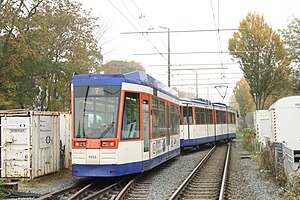SB9
| Tram sidecar SB9 | |
|---|---|
|
9433 car
|
|
| Number: | 30th |
| Manufacturer: | LHB / Adtranz |
| Year of construction (s): | 1994 |
| Length over coupling: | 14,720 mm |
| Width: | 2400 mm |
| Empty mass: | 12.8 t |
| Operating mode: | One-way vehicle |
| Seats: | 48 |
| Standing room: | 42 |
SB9 is a sidecar type of tram Darmstadt , the abbreviation stands for S traßenbahn- B eiwagen the 9 . Series. HEAG owns a total of 30 vehicles of this type, they were manufactured by Linke-Hofmann-Busch and Adtranz and have the company numbers 9425-9454.
With the commissioning of the SB9, the high-floor sidecars of the SB7 and SB8 series were decommissioned. For the first time there were low-floor wagons in Darmstadt , which followed in 1998 with the ST13 series . The SB9 were delivered with a roll-up display , later they were converted to LED displays. The rear lights, which were delivered with incandescent lamps, were also converted and later converted to LEDs (except for reversing lights). All sidecars have a makeshift cab with which the SB9 can also maneuver backwards according to the control car principle.
Structure and equipment
The SB9 is 14.7 meters long and consists of a vehicle module under which there are two double- axle bogies . The sidecars each have a double outer pivoting sliding door and two individual outer pivoting sliding doors, front and rear. The car bodies are structurally similar to the C-part of the somewhat younger ST13 series. Each sidecar offers 48 seats and 42 standing places, so a total of 90 people can be transported. The handrails were originally all painted pink, over the years some of them have been replaced by unpainted aluminum handrails. Since 2011, the seat layout has been changed in the SB9, the penultimate row of seats was laid across so that there is more space in front of the third door and the last row of seats. A row of seats was also built diagonally across from the middle door to make room for the ticket machine.
commitment
All railcars of the series ST10, 11 and 12 were converted for use with the SB9. After that, the converted Tw were no longer able to pull an older Bw from the SB7 or 8 series. This replaced the older Bw series, and from then on the SB9 series were the only Bw in regular operation. 10 Tw of the ST7 series were also converted, so that a total of 34 railcars could take an SB9 with them on the route (ST8s were not converted and ST9 were no longer available). The aim is now to offer a network-wide range of low-floor vehicles behind high-floor multiple units. The HVZ line 1 fell out of the ordinary, from then on it was operated solo (even today), but its stops were "covered" by other lines. Line 3 was only operated by 6xTw (ST7 or 10) with an SB9 from 1994/95 to 2007/08. An 8xTw with 4xBw on Line 3 is not possible due to the short stops. After the shutdowns of the ST7 (1998) and 10 (2008) series, line 3 will only be operated solo with the ST13 and 14 low-floor multiple units. The SB9 series cars can be found on all other lines.
Naming
Three SB9 are named after cities:
